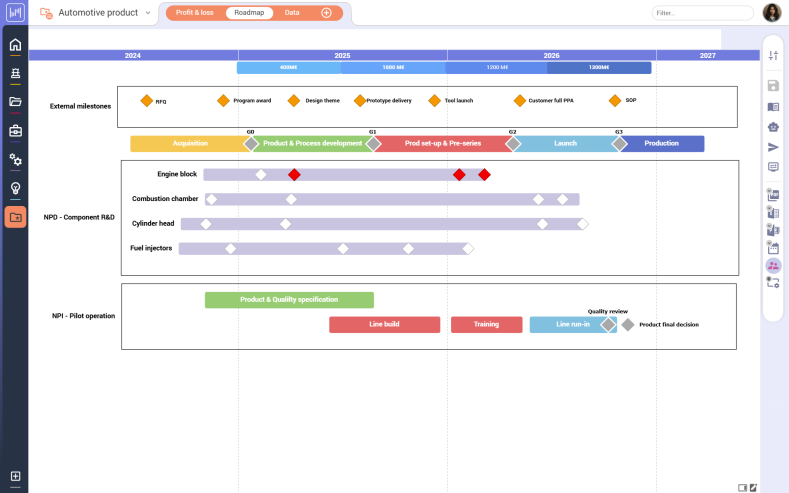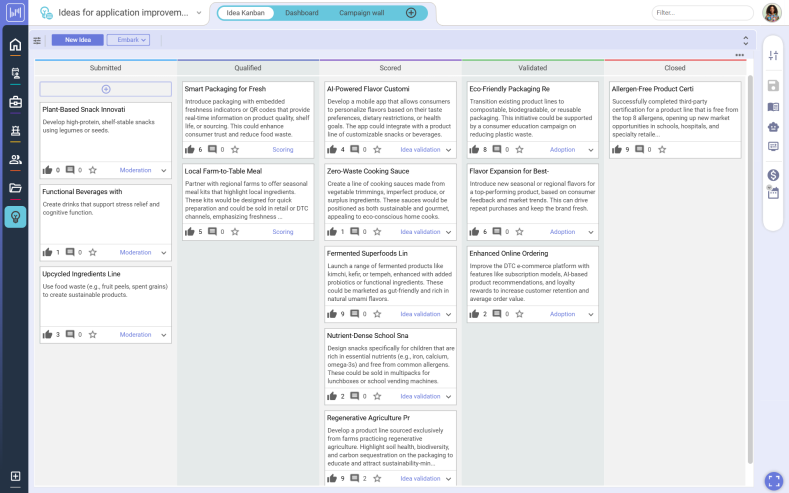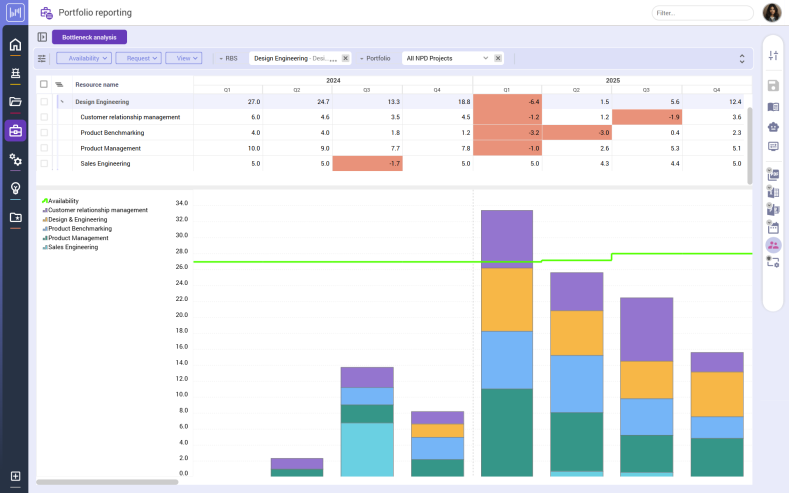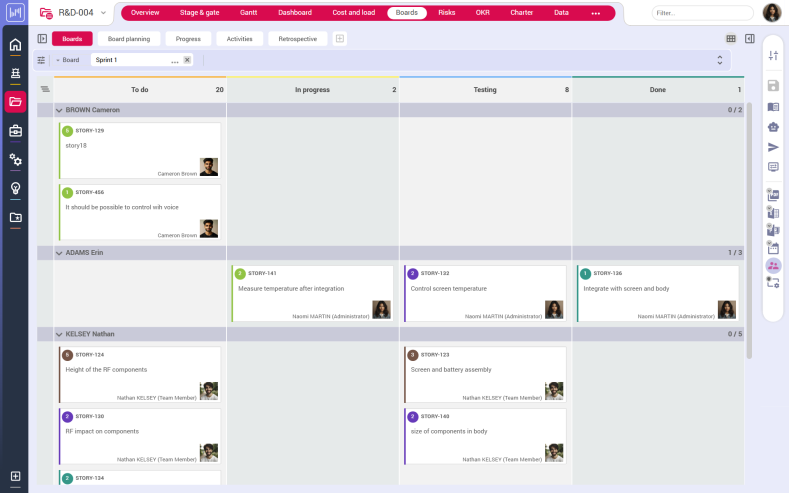Updated: October 2025
New product development (NPD) is an exciting pursuit for any business. But poor process visibility can sap momentum and stall progress before you even get started.
Without a comprehensive view, product managers (PMs) face a greater risk of clashing deadlines and inefficient resource allocation, which can lead to two nightmare-inducing phrases: missed dependencies and bottlenecks.
But seeing just your own product development projects isn’t enough. A full view of all projects allows PMs to understand if and where there are conflicting demands on resources.
This is where project portfolio management (PPM) software can help. These tools offer powerful data aggregation, analysis, and visualization capabilities, giving PMs critical oversight of the entirety of the product pipeline, from top-level strategy down to granular task-level detail.
If you know how to get the most out of your tool, you’ll have a serious edge when building business cases and planning projects. Let’s explore the role of PPM in new product development.
What is PPM in new product development?
Product portfolio management—or product portfolio and program management—is an approach for prioritizing and selecting product development programs. It enhances visibility by creating a strategic, top-down view, enabling product managers to make smarter decisions on resources, prioritization, and timing.
It’s often confused with project portfolio management, also abbreviated PPM. The two are closely related, but not exactly the same. Project PPM is a set of processes for evaluating and optimizing the strategic value of collections of projects, or project portfolios. It’s rooted in best practices for project management and the technology needed to facilitate delivery, reporting, and decision-making.
Product PPM, on the other hand, applies similar principles but to a collection of products and new product development programs, or product portfolios. It gives product managers an overarching view of the entire pipeline, from ideation to market launch. Product PPM uses high-quality data on profitability, ROI, capacity, and timelines to guide decisions around project initiation and resource allocation.
5 benefits of PPM tools and software for product development
The product PPM process is brought to life with the use of tools which, with advances in artificial intelligence (AI) and machine learning (ML), are becoming ever more powerful and sophisticated. They can aggregate data, analyze performance, and present it through intuitive dashboards, offering the visibility and insight product managers need to plan with confidence.
1. Enhanced access to pre-project information
Searching through email attachments or downloads for project documentation can be a drag on productivity and result in mismatched data.
PPM tools offer central, cloud-based storage—a “single source of truth” that all teams can access easily—for key pre-project information such as market analysis, business cases, technical feasibility assessments, and historical project data.
This keeps everyone aligned with objectives at a project and business level. It also allows product managers to quickly validate their assumptions, cross-check with previous outcomes, and make more data-informed decisions about new programs, eliminating the need to manually dig for data or rely on guesswork.
2. Improved product strategy
Modern PPM tools facilitate the creation and management of Agile roadmaps for product development. Agile methodologies are now a staple for both project and product management.
Roadmaps are a key tool for aligning teams on long-term goals, as they connect high-level company vision to actionable work, giving your product development a clear strategic direction.

Roadmaps help ensure every product initiative delivers business value and market impact.
That said, don’t forget that ideation and evaluating market trends still needs the human touch of a PM—people can interpret customer needs and translate business goals into strategic direction in a way that tools just can’t. This ensures that your roadmap reflects real user problems and business objectives, not just data patterns.
However, once your roadmap has this human input, your PPM tool can support quick shifts based on changes in the market and feedback on the product.
Evaluating strategic impact
By providing a strategic view across an entire product portfolio, PPM tools can help PMs construct their business case by highlighting live projects that could benefit from the development of their product idea.
Portfolio dashboards, customized reporting, and what-if scenario modeling are all features that reveal how each product development project contributes to strategic goals.
PPM tools also help PMs to spot potential conflicts between projects and prioritize resources based on each project’s strategic value.
Identifying synergies
In some instances, there may be opportunities to synergize production—that is, reuse existing technology, components, or processes across multiple products to save time and money. With help of PPM tools are adept at surfacing these opportunities through predictive analytics.
3M is a great example of how successful this strategy can be for scaling up. They produce over 60,000 products with varying formats and functions and were able to achieve this by synergizing the production of key components such as adhesives for use across multiple product lines.
3. Accelerated time-to-market
Markets are as competitive as ever—and that’s not to mention the perennial uncertainty of the global macroeconomic landscape. Speed is a crucial factor for the success of product development projects. As a product manager, you’re likely to be under pressure to launch quickly.
By automating workflows, centralizing change requests, and facilitating communication between teams to further streamline the product development process, PPM tools unlock valuable time savings.
Comparing projected ROI to current projects
Excel spreadsheets have served PMs well in the past, but accessing and interpreting the data can be tricky, time-consuming, and leave us working with outdated data.
PPM tools can integrate live financial and performance data from other connected systems, such as CRMs, ERPs, and project tools, into a single dashboard view. They offer real-time reporting and alerts that help product managers to divert or pivot if ROI is expected to drop or a better opportunity arises.
These instant insights can be used to help position your business case.
Elevating idea management
It’s not just about automation. PPM tools can also accelerate creative endeavours; kanban boards, for example, can be used for collaborative ideation, connecting your teams and speeding up concept-to-launch.

Kanban boards can help you capture and evaluate ideas across teams.
By giving visibility of an entire portfolio of projects, product managers can better structure, nurture, and evaluate product ideas.
From there, suggestions can be critiqued and prioritized based on strategic objectives, commercial viability, technical feasibility, resource capacity, risks, and market data (such as the launch of a similar product or material shortages).
After all, there’s no such thing as a bad idea, but in product development, having too many ideas can be its own problem.
4. Optimized resource allocation
Today’s economic uncertainties mean some PMs face a perfect storm of limited resources combined with increased pressure to rapidly roll out new, successful products.
Without a top-down view of priorities and team workloads, resource allocation is challenging to say the least. A PPM tool can provide this oversight, facilitating effective assignment of skills to the most strategically important projects at the right time.
At-a-glance capacity planning
PPM tools allow you to quickly check resource capacity, helping to reveal if you are over or under capacity for live projects and subsequently influence resource planning for your business case.

PPM tools give real-time insights into capacity, skills, and priorities.

Kanban-style sprint boards help product managers track work by person and stage, giving clearer forecasting insights.
5. Smarter forecasting and decision-making
“As soon as possible” isn’t a realistic or strategic approach to setting deadlines in the product development process. On the contrary, historically, forecasting is time-consuming and heavily reliant on estimation.
Thankfully, modern PPM tools can eliminate this laborious (and sometimes erroneous) manual guesswork. They can aggregate historical project data (such as durations and delays) and current team workloads to predict more realistic timelines, and show real-time resource availability and workload heatmaps to prevent overloading or overcommitment.
Supporting different methodologies
PPM tools can accommodate many ways of working to improve decision-making.
For example, when integrated with your project’s stage-gate process, the tool can provide you with relevant data to help hone the stage’s “go” or “kill” decision. This could include projected vs. actual costs, risks and resources, as well as value predictions based on previous project data. Projects can be reprioritized and resources reallocated at each gate.
Once your processes have reached maturity—perhaps as part of an Agile or hybrid approach—and you’ve implemented predictive algorithms, your PPM tool can give you the necessary information to make fast, informed decisions about how to adapt or pivot your project. It may also give you (and your stakeholders) the reassurance you need to continue along the current path.
This is especially essential for product managers operating in competitive, dynamic markets.
How to integrate PPM tools into your product development processes
Implementing a PPM tool requires multiple teams to adapt their tech stacks and behaviors. However, the benefits for product development are worth their weight in golden opportunities. You can maximize your chances of a successful implementation by treating PPM tool implementation like any other project:
- Take stock of your existing situation. Map your existing product development processes and pinpoint their problems for a comprehensive understanding of how things currently look. You may find that product ideas are duplicated across teams and approvals take too long because data is scattered.
- Define your goals and objectives. Now that you know where you are, you need to be clear on where you’re going. Define expected outcomes so you have something to judge success by. For example, you might aim to improve speed to market by 30%, strengthen forecasting accuracy, or reduce duplicated work across teams.
- Pilot your implementation. You can’t implement a new product PPM solution wholesale—rollout should be small scale, incremental, and gradual. When piloting, focus on certain teams who you imagine are likely to embrace and champion the new technology. This will build momentum and give crucial constructive feedback for the wider rollout.
- Train and engage. To ease adoption, plan role-specific training sessions, create quick-start guides, and film live demos. Address feedback while extolling the value of the new tool. Create a new team messaging channel where team members can discuss the tool, ask questions, and give feedback.
- Communicate ongoing success. For example, if approval cycles dropped from three weeks to two weeks during the pilot, make sure everyone knows. Your aim is to build excitement and create a feel-good factor. This could mean sharing wins in team meetings, newsletters, or dashboards, and recognizing early adopters who champion the tool to create a sense of ownership.
Remember, you’re applying unfamiliar technologies to your people and your processes. It’s important to acknowledge that any product PPM solution is unlikely to solve everything right away. The implementation process might highlight extra deficiencies, but the trend should always be towards greater efficiency and innovation.
Level up your product development processes with Planisware
By improving portfolio visibility, optimizing resources, and unlocking more data, our PPM solutions for product development help you to bring new ideas to market faster than ever.
Over a third of the world’s 100 largest R&D portfolios are managed with Planisware. Could yours be next? Book a one-to-one demo to discover how to bring world-class product development and innovation to your organization.


